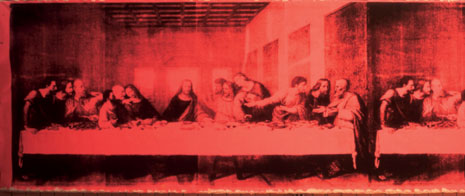Back

This “rose-red” interpretation
from Warhol’s Last Supper series hangs at The Andy
Warhol Museum.
I“I thought that no single work of art would ever
surpass the fame of Leonardo da Vinci's fresco of The
Last Supper created in 1495-8 in the monastery attached to the
church of Santa Maria delle Grazie in Milan. And nothing
has—until the work trumped itself with the publication
of mystery-thriller novelist Dan Brown's The Da Vinci Code,” says
Thomas Sokolowski, Director of The Andy Warhol Museum. “Just
as this tawdry, but mightily engaging novel has made the
world take another look at this renaissance masterpiece,
so too did Andy Warhol ask his viewers to look beyond the
category of ‘masterpiece’ and peer deeply into
this work.”
Created in late 1986, The Last Supper—an
elaborate series of interpretations of Leonardo da Vinci’s
masterpiece—was Warhol’s last substantial work.
(He died from complications
following surgery on February 22, 1987.) It was commissioned
by the Milan bank Credito-Valtellinese where the group
of paintings originally hung, just across the street from
the church that houses Leonardo’s original. While
Warhol’s Last Supper series has always been noteworthy for both
its subject matter and timing, it has received renewed
attention since the novel and recently released movie The
DaVinci Code places Leonardo’s original work at the
center of its plot.
“
Because the book has stirred up so much controversy surrounding
the person sitting to the right of Jesus in Leonardo’s
painting—is it an effeminate Apostle John or Mary
Magdalene, who the book suggests was Jesus’ wife?—people
want to see it for themselves,” says Colleen Russell
Criste, The Warhol’s assistant director of external
affairs. “Since Warhol’s work is based on Leonardo’s,
we find people in the gallery discussing the story all
the time.”
To produce his Last Supper series, Warhol
appropriated Leonardo’s original
image, copying it from a cheap commercial reproduction (as was his practice),
and then creating almost 100 different interpretations. He reproduced it in its
entirety as a double-silkscreened image washed in green, blue, yellow, and rose-red
(it’s this version that hangs in The Andy Warhol Museum). He also created
a black-light version, a camouflage version, and various other interpretations
that incorporate commercial logos for products such as Dove soap and Wise potato
chips. He even pulled out details
from the painting and reproduced them in a series as well, as in Christ 112 Times.
Why
so many different versions? Warhol often used high art, such as The Last
Supper or Leonardo’s other exceptionally famous work, The Mona Lisa, as
source material because the works are so familiar to the general public that
they’ve become almost commonplace. Coloring the works, camouflaging them,
even pulling them apart encourages viewers to look at these highly recognizable
pieces in a whole new way.
“
With this prolific series, Warhol suggests that it doesn't matter whether
or not one has seen the original work, but simply how well known the work
has become
through the many reproductions, both good and bad, that have been made from
it,” says
Sokolowski. “And remember, imitation is the greatest form of flattery.
Even when it comes to high art.”
Back
| Top |